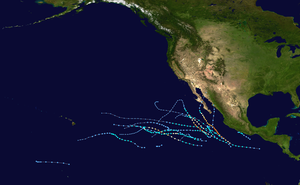
Back Pazifische Hurrikansaison 2004 German Temporada de huracanes en el Pacífico de 2004 Spanish Saison cyclonique 2004 dans l'océan Pacifique nord-est French Temporada de furacões no Pacífico de 2004 Portuguese 2004 Pacific hurricane season SIMPLE 2004年太平洋颶風季 Chinese
| 2004 Pacific hurricane season | |
|---|---|
 Season summary map | |
| Seasonal boundaries | |
| First system formed | May 22, 2004 |
| Last system dissipated | October 26, 2004 |
| Strongest storm | |
| Name | Javier |
| • Maximum winds | 150 mph (240 km/h) (1-minute sustained) |
| • Lowest pressure | 930 mbar (hPa; 27.46 inHg) |
| Seasonal statistics | |
| Total depressions | 17, 1 unofficial |
| Total storms | 12 |
| Hurricanes | 6 |
| Major hurricanes (Cat. 3+) | 3 |
| Total fatalities | None, 3 missing |
| Total damage | None |
| Related articles | |
The 2004 Pacific hurricane season was an overall below-average Pacific hurricane season in which there were 12 named tropical storms, all of which formed in the eastern Pacific basin (east of 140°W and north of the equator). Of these, 6 became hurricanes, and 3 of those intensified into major hurricanes. No storms made landfall in 2004, the first such occurrence since 1991. In addition to the season's 12 named storms, there were five tropical depressions that did not reach tropical storm status. One of them, Sixteen-E, made landfall in northwestern Sinaloa. The season officially began on May 15 in the eastern Pacific, and on June 1 in the central Pacific basin (between140°W and the International Date Line, north of the equator). It officially ended in both basins on November 30. These dates conventionally delimit the period during each year when most tropical cyclones form in each respective basin.[1] These dates conventionally delimit the period during each year when a majority of tropical cyclones form. The season was reflected by an accumulated cyclone energy (ACE) index of 71 units.
Impact throughout the season was minimal and no deaths were recorded. In early August, the remnants of Hurricane Darby contributed to localized heavy rainfall in Hawaii, causing minor street and stream flooding; coffee and macadamia trees were damaged as well. In early September, Hurricane Howard resulted in significant flooding across the Baja California peninsula that damaged agricultural land and 393 homes. Large swells also resulted in about 1,000 lifeguard rescues in California. In mid-September, Javier, the strongest hurricane of the season, caused three fishermen to go missing and helped alleviate a multi-year drought across the Southwest United States. It produced record rainfall in the state of Wyoming. In mid- to late October, Tropical Storm Lester and Tropical Depression Sixteen-E each dumped heavy rain upon parts of Mexico, resulting in minor flood and mudslide damage.
- ^ "Frequently Asked Questions". Central Pacific Hurricane Center. May 12, 2016. Retrieved December 31, 2016.